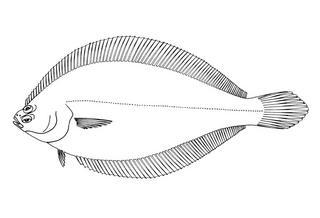
www.fao.org Copyright Michel Lamboeuf · 0
Etropus ectenes |

Click on map for details about points.
|
| Links |
We parsed the following live from the Web into this page. Such content is managed by its original site and not cached on Discover Life. Please send feedback and corrections directly to the source. See original regarding copyrights and terms of use.
- FishBase
|
|
español |
|
|
Overview |
Main identification features
- eyes and head small
- body height less than less than 1/2 sl
- pectoral: bars
- lateral line has 54-55 scales
- dorsal fin 88-96 anal fin 68-78
Eyes on left side; relatively slender, body height 41-44% of standard length; head small, 21-25% of standard length, pointed; upper eye at edge of head and partly over midline crest that extends between eyes; mouth small, 20-25% of head length; most of teeth on blind side, in 1 row on both jaws; 8-9 rakers on lower arm of 1st gill arch; lateral line not extending onto head and without arch over pectoral, relatively straight; base of eye side pelvic on midline of body; urinary papilla on blind side, immediately behind anus; pectoral 67-77% of head length; 92-95 dorsal rays; 73-76 anal rays; 54-55 lateral line scales.
Eye side grey to grey-brown, with dark blotches, fins spotted, pectoral with irregular bars; blind side pale.
Size: 24 cm.
Habitat: shallow soft bottoms, including estuaries.
Depth: 0-50 m.
Panama to Peru.
Attributes
Abundance: Common.
Cites: Not listed.
Climate Zone: Equatorial (Costa Rica to Ecuador + Galapagos, Clipperton, Cocos, Malpelo); South Temperate (Peruvian Province ).
Depth Range Max: 50 m.
Depth Range Min: 0 m.
Diet: octopus/squid/cuttlefish; mobile benthic worms; mobile benthic crustacea (shrimps/crabs); bony fishes.
Eastern Pacific Range: Northern limit=8; Southern limit=-15; Western limit=-82; Eastern limit=-73; Latitudinal range=23; Longitudinal range=9.
Egg Type: Pelagic; Pelagic larva.
Feeding Group: Carnivore.
FishBase Habitat: Demersal.
Global Endemism: Tropical Eastern Pacific (TEP) endemic; East Pacific endemic; All species.
Habitat: Estuary; Mud; Sand & gravel; Soft bottom (mud, sand,gravel, beach, estuary & mangrove); Soft bottom only.
Inshore Offshore: Inshore; Inshore Only.
IUCN Red List: Not evaluated / Listed.
Length Max: 24 cm.
Regional Endemism: Continent; Continent only; TEP endemic; Continental TEP endemic; Panamic province endemic; All species.
Residency: Resident.
Salinity: Brackish; Marine.
Water Column Position: Bottom; Bottom only;
|
|
|
Names | |
|
|
|
Links to other sites | |
|
|
|
References |
- Abbott, J.F., 1899., The marine fishes of Peru., Proc. Acad. Nat. Sci. Phila., 51:324-364.
- Béarez, P., 1996., Lista de los Peces Marinos del Ecuador Continental., Revista de Biologia Tropical, 44:731-741.
- Fischer , W. , Krup , F. , Schneider , W. , Sommer , C. , Carpenter , K. E. and Niem, V. H., 1995., Guia FAO para la Identificacion de Especies de para los fines de la Pesca. Pacifico Centro-Oriental. Volumen III. Vertebrados - Parte 2., FAO3:1201-1813.
- Hildebrand, S.F., 1946., A descriptive catalog of the shore fishes of Peru., Bull. U.S. Nat. Mus., 189:1-530.
- Jimenez-Prado, P., Béarez, P., 2004., Peces marinos del Ecuador continental / Marine fishes of continental Ecuador., SIMBIOE/NAZCA/IFEA tomo 1 y 2.
- Jordan , D. S. and Goss, D. K., 1889., A review of the flounders and soles (Pleuronectidae) of America and Europe., Rept. U.S. Fisheries Comm., 14:225-342.
|
|
|
Acknowledgements | |
I thank Ashley MacDonald and John Pickering, University of Georgia, for technical support in building this page.
|
|
| Supported by | |
|
Following modified from FishBase
|
Top | See original
http://www.fishbase.org/Summary/speciesSummary.php?genusname=Etropus&speciesname=ectenes ---> http://192.134.151.83/Summary/speciesSummary.php?genusname=Etropus&speciesname=ectenes
http://192.134.151.83/Summary/speciesSummary.php?genusname=Etropus&speciesname=ectenes ---> https://fishbase.mnhn.fr/Summary/speciesSummary.php?genusname=Etropus&speciesname=ectenes
&pull 20q v5.145 20180528: Error 501 Protocol scheme 'https' is not supported (LWP::Protocol::https not installed) https://fishbase.mnhn.fr/Summary/speciesSummary.php?genusname=Etropus&speciesname=ectenes |
Updated: 2024-04-20 02:14:18 gmt
|